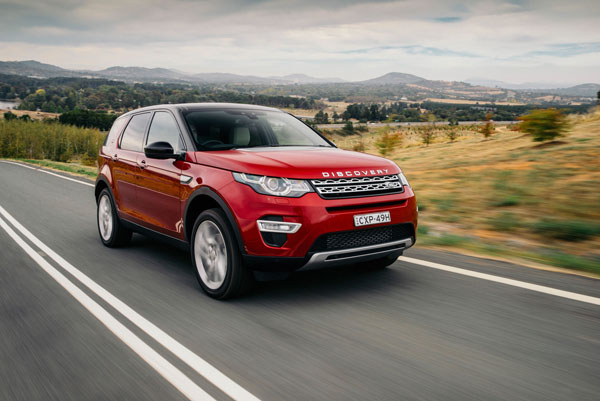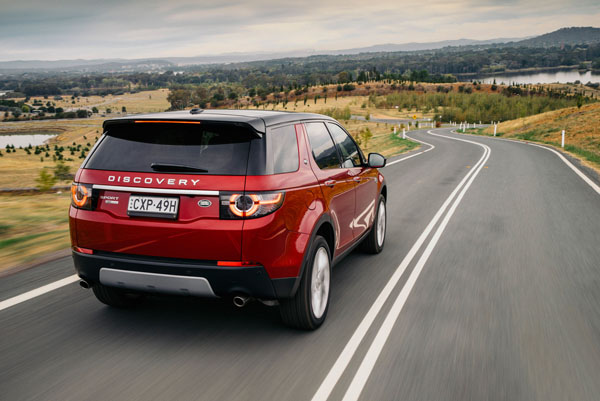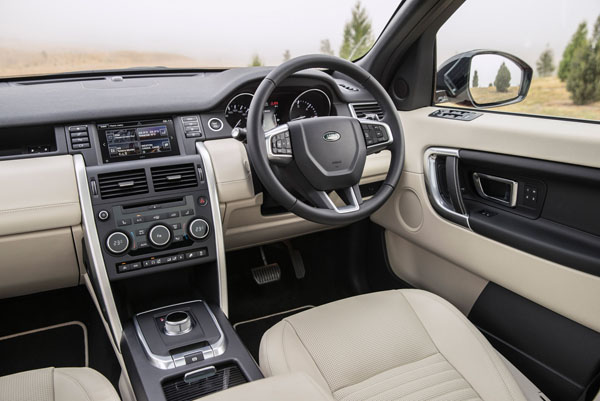
What to get if you like the Range Rover Evoque but need more space; like the Discovery but don’t have the readies; want a bit of Range Rover style and capability?
Oddly enough, you buy a Land Rover Discovery Sport. The Freelander replacement has been with us for just over a year now and is finding plenty of homes with its pretty looks and the promise of mud-plugging shenanigans should the need arise.
VALUE
The Discovery Sport HSE SD4 is the mid-spec trim level, starting at $61,100 for the manual and $63,600 for the nine-speed automatic.
HSE means 10-way adjustable electric seats which are also heated and cooled, powered tailgate, leather trim, autonomous emergency braking, front and rear parking sensors and reversing camera, dual-zone climate control, eleven-speaker stereo with USB and Bluetooth, sat-nav, headlamp washers, auto headlights and wipers, keyless entry and start, graphical park assist and cruise control.
Our test car had the $2100 cosmetic Black Pack which adds black wheels, black trim and black grille to mean things up a bit. It looks good but the outlay is significant.
Added to this was a panoramic glass roof ($1800), dark glass for the rear windows ($600), DAB ($540), InControl Apps for linking your smartphone to the car’s systems ($530) and ebony headlining ($460) for a grand total of $69,640.
DESIGN
Both Freelanders were, sadly, a bit gawky. The first one was a forgettable mess and the second little better so this larger, more confident design could only have really worked with a new name.
It’s more Evoque than Discovery, more Range Rover Sport than Defender, meaning sleek bi-xenon headlights, cool details and practical shape that falls in between the Evoque and Discovery.
The Sport HSE rides on nineteen-inch wheels and with the black pack against the Fuji White of the test car, looks very sharp and modern and hides its 4.6m length well.
Inside is well-built with a good mix of materials and few dodgy ones. The middle row slides and each of the seats reclines for a bit of extra comfort. Leg and headroom is excellent in the rear, that higher roofline paying dividends even with the high-set seats.
The powered-tailgate reveals a 981-litre boot that almost doubles with the seats down. So you can get a hell of a lot into the Sport. The significantly larger Discovery, for reference, has 1260 and 2558 litres respectively.
SAFETY
Seven airbags, autonomous emergency braking, ABS, stability and traction controls, brake assist, hill descent control, rollover stability, forward collision mitigation, trailer sway control and lane departure warning.
INFOTAINMENT
Jaguar Land Rover’s improved sat-nav/entertainment software powers an 8.0-inch screen set into the dash. The software integrates with a smartphone app that adds extra apps to the screen and is connected via Bluetooth. It’s no world-beater (or CarPlay or Android Auto) but it can be quite useful.
The standard eleven speaker stereo is very good but the interface can be a bit difficult to master, the DAB controls are particularly baffling (although hardly anybody does it right) and the screen itself needs to be a lot more responsive if the company is to persist with touch screens.
ENGINE / TRANSMISSION
Under the high bonnet lies Land Rover’s Ford-sourced 2.2 litre in-line four-cylinder turbo-diesel, churning out 140 Kw and 420 Nm of torque, pushing the 1765 kg SD4 to 100km/h in 8.9 seconds.
The nine-speed ZF automatic transmission helps achieve a claimed 6.1L/100km via stop-start and, seemingly, a gear for every occasion. In city-only driving we struggled to get below 11L/100km but a run down the coast saw the figures dive to 8.2L/100km.
DRIVING
The Freelander was always considered a little on the soft side of things. It was also a bit sub-par in the driving department. Things have changed.
LR’s Terrain Response Control features five settings for different types of terrain and two for tarmac, one of them being “Dynamic”. It’ll wade through up to 60 mm of water and tow up to 2200 kg.
Of course, the vast majority of these will spend all of their time on urban roads and never leave. As with its bigger brothers, the Discovery Sport manages to be impressive both off-road and on, which is quite a feat, particularly if you consider its size and weight.
Its tarmac behaviour is impressive – excellent ride, quiet engine, smooth transmission. It will roll impressively through fast corners, but it holds its own with the all-wheel drive system shuffling the power around.
The only downside is the breath it takes when you sink the throttle for a quick launch into traffic. Like anything you learn to live with it, but a bit more throttle response on the road would be most welcome.
Passengers enjoyed the Sport’s space and with the panoramic roof open, either loved the light or bemoaned being cooked in the bright Sydney sun. Entry and exit for normal sized people is good, with an easy step-in and out rather than a climb in. It looks high, but it isn’t really.
SUMMING UP 3.5/5
The Discovery Sport takes on the German rivals with its far more stylish exterior and backs it up with decent spec-level and a far more impressive off-road performance. The Germans don’t pretend they can do it, but Land Rover proves you can have both.
Likes: on and off-road performance, attractive looks, LR cache
Dislikes: hesitant take-off, some options are hugely expensive, thirst some way off official figures













